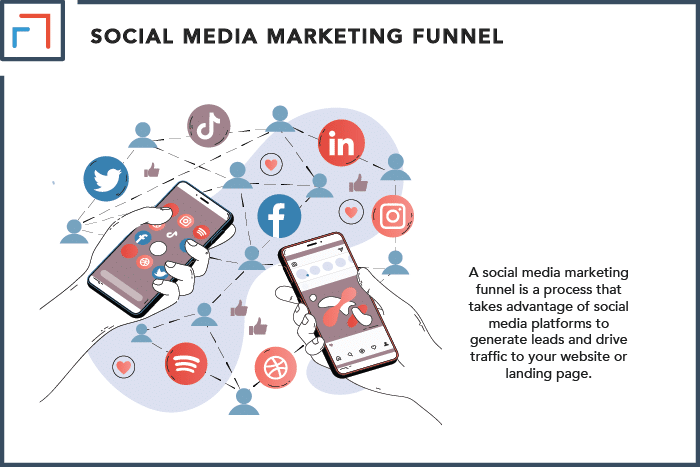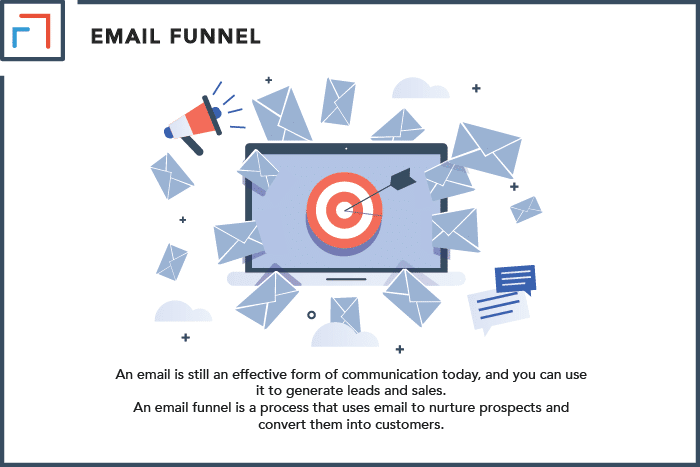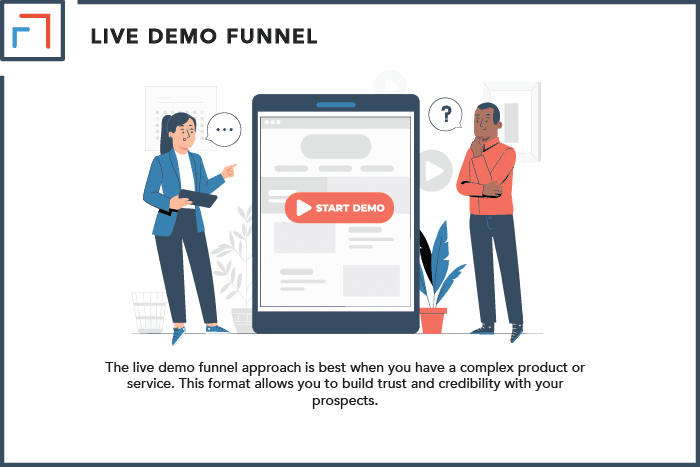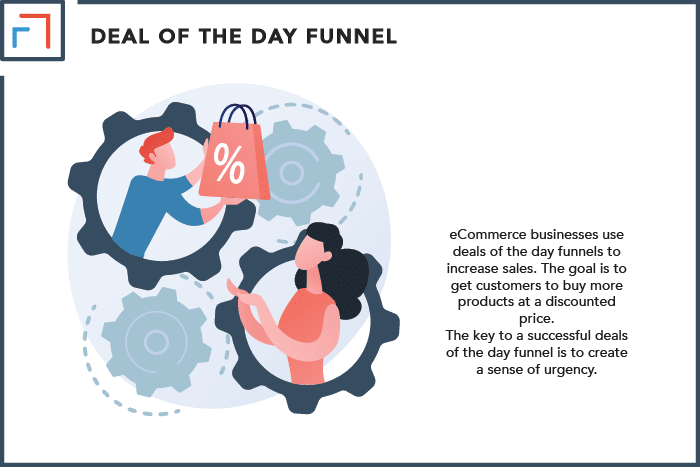Most people use the terms marketing and sales interchangeably, but they are quite different. Sales is the process of converting a lead into a paying customer, while marketing is the process of generating leads. That said, there is a difference between sales and marketing funnels.
Types of funnels in marketing include social media, list building, free sample, email, lead magnet, webinar, product launch, consultation, retention, and live demo funnels. The objective of each funnel is different, but the ultimate goal is to generate leads and pass them to the sales team.
The most important thing to remember about marketing funnels is that they are not all-purpose models. The funnel you choose will depend on your product, audience, and goals. Now that you know the basics let’s go over each funnel type in more detail.
12 Most Common Types of Marketing Funnels
1. Social Media Marketing Funnel
On average, people spend over 2 hours each day on social media. That’s a lot of time that businesses can use to reach their target audience.
A social media marketing funnel is a process that takes advantage of these platforms to generate leads and drive traffic to your website or landing page.
For effective lead generation, you should have a plan and be strategic with your social media marketing.
- Create social media accounts on the platforms where your prospects are most active.
- Once you have a presence on these platforms, you can start creating content that will appeal to your potential customers and drive them to your website or landing page.
- Some businesses make the mistake of driving traffic to their homepage. Instead, it’s essential to direct traffic to a specific landing page where you can collect contact information.
- Your social media marketing funnel doesn’t end there. Once you have captured a lead, you must follow up and nurture the relationship. You can send informational emails, run ads, or even offer a free consultation.
Once the leads meet your set criteria, you can pass them on to the sales team.

2. List Building Funnel
How do you get people to sign up for your email list? The answer is simple: you need a lead magnet.
A lead magnet is an irresistible offer that entices prospects to exchange their contact information for something of value.
A lead magnet can be anything from an ebook to a checklist or even a free trial. The key is to offer something that provides value to your target audience.
For example, depending on your industry, you might offer a free workout guide, a free credit report, or a budget template.
Once you have your lead magnet, the next step is to create a landing page to host it. You should include a form where prospects can enter their contact information in exchange for access to the lead magnet.
Having a strong call-to-action (CTA) on your landing page is essential. The CTA should be clear and concise. It should also tell the prospect what they need to do next.
3. Free Sample Funnel
There is no better way to get someone to try your product than to give them a free sample. Free samples are an effective marketing tool because they allow prospects to try your product without any risk.
The first step in creating a free sample funnel is to choose the right product. You want to choose a product that is representative of your brand.
It should also be something that your prospects will enjoy/find useful. Whether you want to offer a physical or digital product, ensure it’s high quality.
You don’t want to give away something that is low quality because it can reflect poorly on your brand. Avoid giving away too much because you want to entice potential customers to buy more.
One industry that does this well is SaaS (software as a service) companies. They frequently offer a free trial for prospects to get a taste of the product before paying for it.
After trying the product, the prospect recognizes the value and is more likely to convert into a paying customer. You can offer free samples online or deliver them in person.
Email marketing is a great way to promote free samples.
4. Email Funnel
After the invention of email in 1965, it quickly became the go-to method of communication for businesses.
An email is still an effective form of communication today, and you can use it to generate leads and sales. An email funnel is a process that uses email to nurture prospects and convert them into customers.
1. It starts with building an email list. You can do this by creating a landing page with an opt-in form.
2. Once you have built your email list, the next step is to segment it. You should segment your list based on factors like age, gender, location, etc. Segmenting your list makes it easier to send targeted emails.
3. The next step is to create email content that will appeal to your target audience. Your content should be educational and informative.
4. Once you have created your email, the final step is sending it to your list. You can use an autoresponder to automate this process.
Emails should be sent regularly to keep your list engaged. You can also use email to promote special offers and discounts.
Analyzing your results helps improve your email marketing funnel. You should track your open and click-through rates. You can also use A/B testing to improve your results.

5. Webinar Funnels
During the COVID-19 pandemic, webinars became a popular way to connect with prospects and customers. Webinars allow you to host an online event where you can present your products or services.
You can use webinars to generate leads, build relationships, and close sales. Webinars can be live or pre-recorded. They are generally about one-hour long, but you can go longer or shorter if necessary.
A webinar format is typically a presentation followed by a Q&A session.
1. The first step in creating a webinar funnel is to choose the right topic. You want to choose a topic that is relevant to your audience and will generate interest.
2. The next step is to promote your webinar. You can do this through email, social media, and paid advertising.
3. You should also create a landing page for your webinar. Your landing page should include all the details about your webinar. It should also have an opt-in form where prospects can sign up.
4. On the day of the webinar, you will need to send a reminder email to your list. You should also promote your webinar on social media.
Once the webinar is over, send a follow-up email to everyone who attended. This email might also include a link to the recording of the webinar.
You can also use the post-webinar email to further promote your products or services. If you do this, you should include a link to a sales page or order form in your follow-up email.
6. Product Launch Funnel
Building buzz around a new product launch is essential for generating quality leads. A product launch funnel uses marketing and sales strategies to increase interest in a new product.
When planning a product launch, you need to create a timeline. This timeline should include all the steps from pre-launch to post-launch. You should start promoting your product a few weeks before the launch.
You can do this through email, social media, and paid advertising. You should also create a sales page for your product.
Your sales page should include all the details about your product, including its price, features, and benefits. Most product launches include a free trial or discount.
You can use this to generate leads and sales. The key is to ensure your offer is irresistible. Time-limited offers are a great way to create a sense of urgency.
You can also use post-purchase emails to upsell and cross-sell your products. This is a great way to increase customer lifetime value.
Analyzing your results will help you improve your product launch funnel. Track your sales and conversion rates so you can identify your strengths and weaknesses.
7. Live Demo Funnel
The live demo funnel approach is best when you have a complex product or service. This format allows you to build trust and credibility with your prospects.
With the advent of video conferencing, live demos have become more popular. You can use this technology to connect with prospects anywhere in the world.
On your website, you should have a page that promotes your live demo. The page should also include an easy-to-use sign-up form.
When conducting a live demo, you should be prepared to answer any questions the prospect may have. You should also have a slide deck or product sheet to reference.
After the demonstration, you should have a Q&A session to address any concerns the prospect may have. As a follow-up, send a live demo recording to everyone who attended.
You can also use this recording to generate leads.

8. Consultation Funnel
The key difference between a live demo and a consultation funnel is that you are not selling a physical or digital product. Instead, you are offering your expertise.
Consultation funnels are common in the coaching and consulting industry. Financial advisers and real estate agents also use them.
The goal of a consultation funnel is to book more appointments. You can use this type of funnel to sell high-ticket services.
Positioning yourself as an expert is essential in a consultation funnel. You can use blog posts, eBooks, and whitepapers to build your reputation and credibility.
Having a steady social media presence is also essential. You should regularly share relevant and valuable content.
9. Retention Funnel
The sales and marketing funnel teams are often interdependent. Therefore, they need to work together to create a retention funnel.
A retention funnel is designed to keep your customers happy and engaged. It starts with the onboarding process and extends to customer support.
The goal of a retention funnel is to reduce customer turnover. You can do this by providing quality products and services.
You should also have a robust customer support system so people can get help instead of leaving immediately.
In addition, offering loyalty programs and discounts can keep your customers engaged. You should also regularly update them on new products and services.
The bottom line is that a retention funnel requires ongoing effort. Therefore, you must constantly monitor and adjust your strategies to reduce customer turnover rates.
10. Cross-sell Funnel
A cross-sell funnel is similar to a retention funnel because it is also designed to keep your customers engaged. But instead of focusing on existing customers, it targets new prospects.
A cross-sell funnel is typically used by companies that offer multiple products and services. The goal is to upsell the customer on a higher-priced product.
You can use cross-sell marketing funnels to promote complementary products. For example, if you sell shoes, you might upsell the customer on socks and insoles.
The objective of a cross-sell funnel is to increase the average order value. You can do this by offering bundle deals and discounts.
For example, web hosting companies often use cross-sell marketing funnels to sell domain names and email services. The goal is to get the customer to buy additional products.
11. Video Marketing Funnels
To get more views, subscribers, and customers, you need to create a video marketing funnel.
The first step is to create engaging videos that provide value to your audience. You can use tools like Canva and Powtoon to create high-quality videos.
Once you have created your videos, you can promote them through social media and email marketing. You can also use paid advertising to reach a wider audience.
A video marketing funnel aims to get more views, subscribers, and customers. You can use this type of funnel to sell products and services.
The funnel is popular in brand awareness and lead-generation campaigns. Therefore, it is ideal for small businesses and startups.
As your audience grows, you can start selling products and services through your videos. You can also use video marketing funnels to promote events and webinars.
12. Deals of the Day Funnel
eCommerce businesses use deals of the day funnels to increase sales. The goal is to get customers to buy more products at a discounted price.
You can create a deals of the day marketing funnel by offering discounts and coupons on your website.
You might want to offer even greater discounts during special occasions like Black Friday and Cyber Monday.
The key to a successful deals of the day funnel is to create a sense of urgency. You can do this by setting a time limit on the discount.
Using social media and email marketing to promote your deals is a great way to reach a wider audience. The bottom line is that the deals of the day funnel can help you increase sales and revenue.
However, you need to ensure that you offer quality products at a discounted price.

Key Takeaways
Although marketing and sales funnels are different, they are both essential to your business. The complementary nature of these two processes can help you generate more leads and sales.
There are many different marketing funnels, and each type has a different goal. The key to creating a successful marketing funnel is to clearly define your goals and objectives.
Whether you want to increase your contact list or create product awareness, you should create a marketing funnel that is aligned with your business goals.
